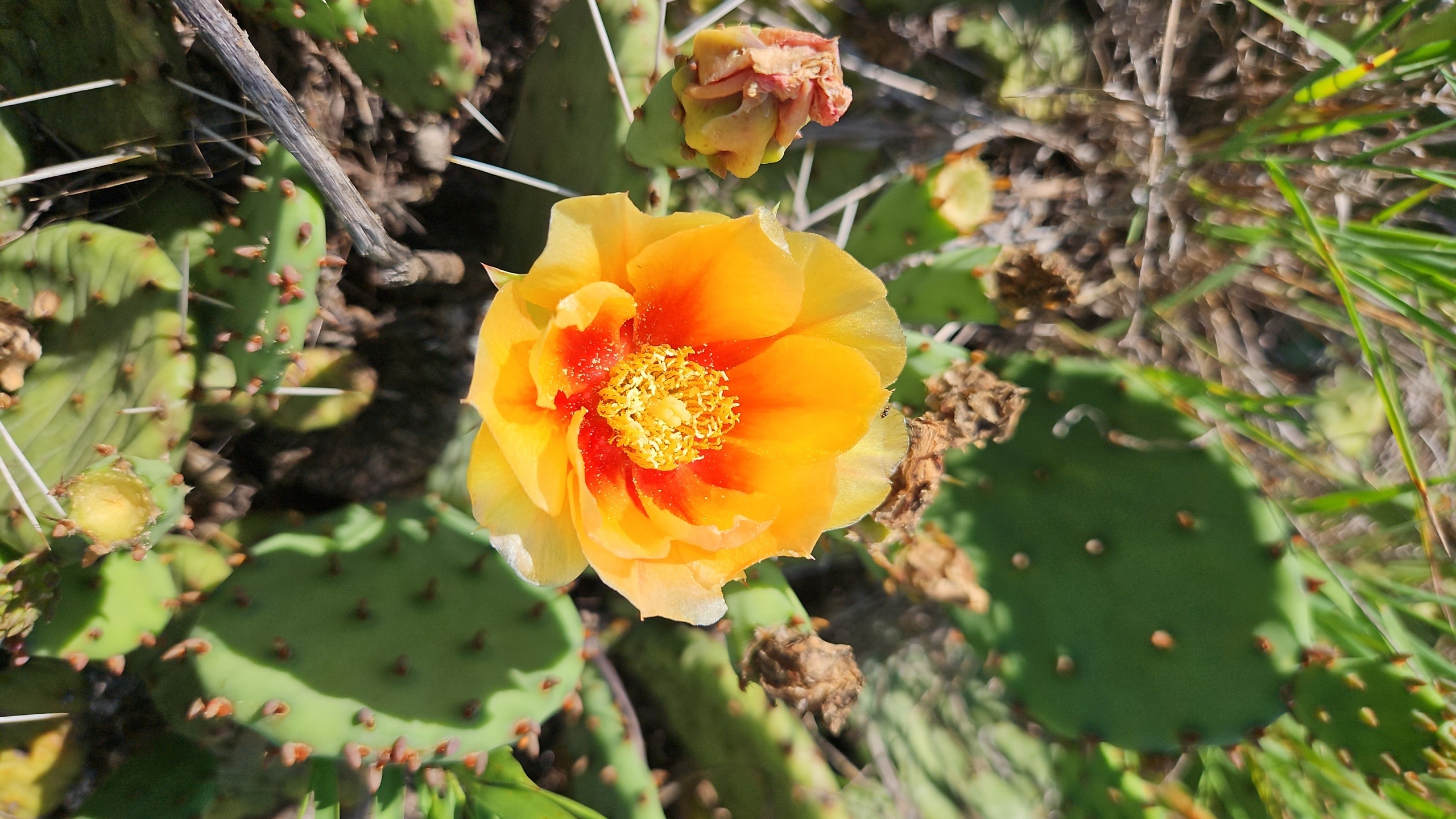Nature nerd Emily Bredthauer took the pictures enclosed below at Eddyville Sand Prairie on June 28, 2025.
“…the joy of prairie lies in its subtlety. It is so easy—too easy—to be swept away by mountain and ocean vistas. A prairie, on the other hand, requests the favor of your closer attention. It does not divulge itself to mere passersby.” ~ Suzanne Winckler (2004, Prairie: A North American Guide)
I am quite partial to a woodland. My ears long to be enchanted by the melody of a stream. I am most comfortable and familiar with the long shadows of trees and the scampering about of squirrels. During the long summer days, that’s where the mosquitoes most want to be too. So this summer, I have been checking out some prairies.
At Eddyville Sand Prairie, I was pleasantly surprised to find a cactus, the Eastern Prickly Pear (Opuntia humifusa). Eddyville Sand Prairie is one of a small number of sand prairie remnants in Iowa. It was formed from sand deposits left by glaciers in the Des Moines River floodplain. Wind carved the sand into dunes.
This rare ecosystem of open, dry grasslands and sandy soil provides a home for unique plant and animal life, including race runner lizards, cacti, and the endangered ornate box turtle: an indicator species of the sand prairie environment. The ornate is particular about its habitat in the Midwest – it must have sandy soil so that it may burrow far enough into the ground to escape the freeze. This terrestrial turtle eats the blooms of the prickly pear cactus.
As I walked the Sam Rogers (sand prairie enthusiast) Educational Trail, I began to see pops of yellow, pink, and green among the very khaki dunes.



An interpretive sign along the trail provided some insight into how special this wildflower truly is:
PRICKLY PEAR CACTUS (Opuntia humifusa)
Listed as Endangered in lowa; found
in only 7 places around the state.
The fruit on this plant, called tuna,
is red, bristly, and pear shaped. (lt is
edible when cooked right.)
Prickly pear can grow in large colonies or as a few individual plants, but either way, it must have lots of sun.


Opuntia humifusa blooms in June. These photos are from June 28. The flowers I observed were bright yellow, most with orange radiating out on the inner tepals from the center. Each bloom is diurnal, living only for a single day.


The stems (called pads) of the cactus are 2-7 inches long and 1.5-5 inches across. Flowers grow at the ends of the pads.




Fruits replace the flowers.
While admiring the flowers, I became aware of the spines and sharp bristles (glochids) present in the areoles.
According to this article on the USDA website, “Because of special antifreeze chemicals in its cells, it can survive the freezing temperatures of the northern and middle states. The roots need to be dry during winter to prevent rot, so well drained sites are necessary.”



“They are usually yellow, but east of the Appalachian Mountains and on dunes, the center is often red to orange.”



While I still consider myself a nemophilist, I have grown to appreciate the uncommon beauty, balance, and strength of the sand prairie through discovery of the Eastern Prickly Pear Cactus.




1 Comment
Thank you, Emily!
It says something about the too-common human disregard for indigenous grasslands that there isn’t even a word like “nemophilist” for those of us who are crazy about prairies. Thank you, Emily Bredthauer, for sharing these photos. It has been years since I saw Eastern Prickly Pear in a different sand prairie, and it is very cheering to see these beautiful flowers.
Iowa sand prairies are wonderful places, and the ones that don’t have Eastern Prickly Pear still provide habitat for other uncommon plants and animals. They are especially important for reptiles, and most Iowa reptile species are officially declining, threatened, or endangered. Even the once-common bullsnake is now proposed for “Threatened” status.
I’ve been advised by wildlife biologists that anyone who sees an uncommon reptile should not post that information on public social media unless the information is vague enough to protect the animal. (E.g., please don’t post “saw a box turtle in a shallow burrow about fifteen yards northwest of the intersection of X and Y roads.”) Unfortunately, one of the serious threats to Iowa reptiles is illegal taking, a.k.a. poaching.
PrairieFan Wed 16 Jul 5:41 PM